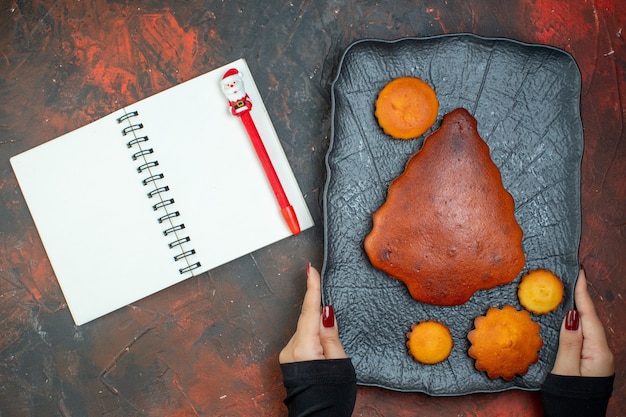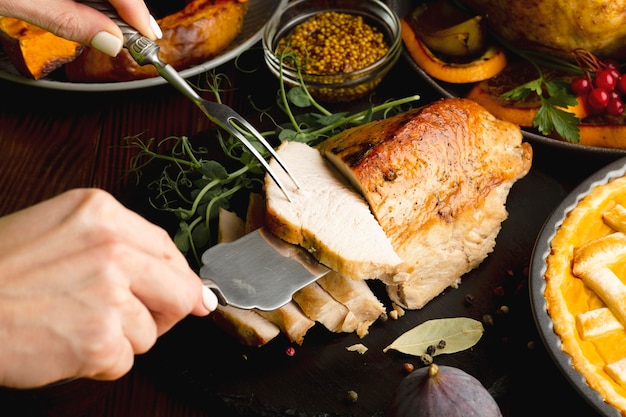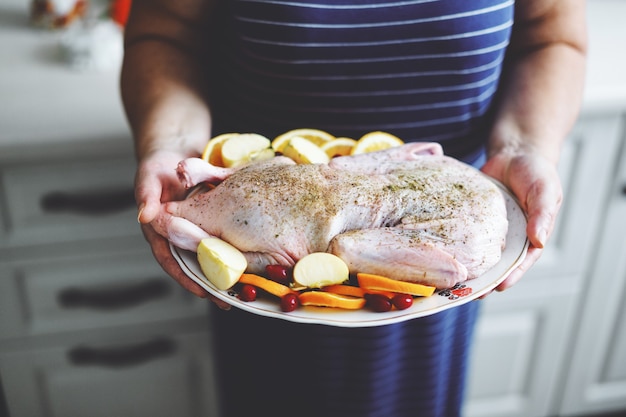Ah, the turkey. The centerpiece of any festive gathering, the star of the show, the reason we all gather around the table (and maybe even fight over the last drumstick!). But roasting a turkey can be a bit of a daunting task, especially if you're new to the game.
This guide is a comprehensive look at everything you need to know about roasting a 12-pound turkey, from choosing the right bird to creating the perfect gravy. Let's dive in and make sure your turkey is the talk of the town, for all the right reasons!
(Part 1) Choosing Your Turkey: The First Step to Success

The Big Decision: Fresh or Frozen?
First things first, you need to decide whether you want a fresh or frozen turkey. Fresh turkeys, in my opinion, are always the way to go. They have a more intense flavour and tend to be juicier. However, if you're working with a frozen turkey, it's crucial to thaw it properly before you start cooking.
Size Matters: Picking the Perfect Bird for Your Feast
A 12-pound turkey is a great choice for a family gathering of 6-8 people. You'll have enough leftovers for sandwiches, soup, or even a festive turkey pot pie! But remember, if you're expecting a larger crowd, you'll need to adjust the size of your turkey accordingly.
The Turkey Check-Up: Ensuring a Healthy Bird
Before you start cooking, it's essential to give your turkey a thorough check-up. Make sure it's plump and well-shaped, with no signs of bruising or discoloration. You're looking for a healthy, happy bird that's ready to become the star of your dinner table.
(Part 2) Preparing for Roast-tastic Success: Setting the Stage for a delicious turkey

The Big Thaw: Unveiling the Frozen Feast
If you've chosen a frozen turkey, you'll need to thaw it properly before you can even think about roasting it. The safest and most reliable method is to thaw it in the refrigerator. This takes about 24 hours for every 4-5 pounds of turkey, so a 12-pounder will need a good two days to thaw completely. Don't be tempted to speed up the process by thawing it at room temperature – it can lead to bacterial growth, which can make you ill.
Brining: The Secret Weapon for a Juicy, Flavorful Turkey
Now, let's talk about brining. This is where things get seriously delicious. Brining involves soaking the turkey in a salt-water solution, which helps retain moisture and makes the meat super tender. It's a game-changer, and honestly, once you've tried brined turkey, you'll never go back.
My Go-To Brine Recipe: A Simple Formula for Flavor
Here's the brine recipe I use for my turkeys. It's simple, yet incredibly effective:
1 cup kosher salt: This is the key ingredient that draws moisture into the turkey, ensuring it stays juicy.
1 cup brown sugar: Adds a hint of sweetness and helps balance the saltiness.
1/2 cup fresh herbs: Herbs like rosemary, thyme, and sage lend a wonderful aroma and flavour to the turkey.
1 gallon water: This is the base for the brine solution.
Mix all the ingredients together in a large container, submerge your turkey in the brine, and let it sit in the fridge for 12-24 hours. Don't forget to cover the container with plastic wrap or a lid to keep the brine from evaporating.
The Butter Ceremony: Adding a Layer of Flavor and Crispness
After the brining process, give your turkey a good pat dry with paper towels. Now, it's time for the buttering ceremony! This is where you really get to bring out the flavour and crispiness of the skin. Take some softened butter and rub it all over the turkey, making sure to get under the skin as well. This will help create a beautiful golden-brown crust and infuse the meat with rich flavour.
(Part 3) roasting time: Let's Get Down to Business!

Preheating: A Crucial Step for Even Cooking
Before you even think about placing your turkey in the oven, preheat it to 325°F (165°C). A hot oven ensures even cooking and helps prevent the turkey from drying out.
The Turkey Goes In: Setting the Stage for a Feast
Place your turkey breast side up in a roasting pan. You can add some vegetables like carrots, celery, and onions to the bottom of the pan for extra flavour. These vegetables will release their sweetness and juices as they cook, creating a delicious foundation for your gravy.
Roasting Time: The Big Reveal
So, how long do you roast a 12-pound turkey? Here's a general guideline:
12-14 pound turkey: 3-3.5 hours
It's important to note that this is just a starting point. The actual roasting time will vary depending on your oven, the size of your turkey, and how much stuffing you're using.
Temperature Matters: The Key to Perfection
The most important thing is to cook your turkey to an internal temperature of 165°F (74°C) in the thickest part of the thigh. This ensures that the turkey is cooked through and safe to eat. Use a meat thermometer to check the temperature – it's the only way to be sure.
Resting Time: Letting the Juices Redistribute
Once your turkey is cooked, don't be tempted to carve it right away. Let it rest for at least 15 minutes before you start carving. This allows the juices to redistribute throughout the meat, resulting in a juicier and more flavorful bird. Cover the turkey loosely with foil to help it stay warm during this resting period.
(Part 4) Don't Forget the Trimmings! The side dishes That Complete Your Feast
Stuffing: The Classic Companion
Stuffing is a classic side dish for turkey, but it needs to be cooked separately. I prefer to make my stuffing ahead of time and bake it in a casserole dish. This allows the stuffing to cook thoroughly and evenly.
Cranberry Sauce: A Tart and Tangy Tradition
Cranberry sauce is a traditional holiday staple, and it's a perfect complement to the richness of the turkey. You can buy it pre-made, but it's really easy to make your own. My favourite recipe is a simple mix of cranberries, orange juice, and a bit of sugar.
Side Dish Ideas: Rounding Out Your Feast
Here are some other delicious side dish ideas to complete your turkey dinner:
mashed potatoes: A classic comfort food that's always a crowd-pleaser.
green bean casserole: A creamy and cheesy side dish with a touch of crispy fried onions.
Roasted vegetables: A simple and healthy option that showcases the natural flavors of seasonal vegetables.
sweet potato casserole: A sweet and creamy casserole with a crispy topping.
(Part 5) Troubleshooting Turkey Trouble: Dealing with Unexpected Challenges
Dry Turkey: Restoring Moisture
Sometimes, even with the best intentions, a turkey can turn out a bit dry. If your turkey is dry, don't fret! You can add some moisture by basting it with pan drippings or adding a bit of broth to the roasting pan. This will help to rehydrate the meat and give it a more succulent texture.
Overcooked Turkey: A Sad Story but Not a Total Loss
Overcooked turkey is a real bummer. To avoid this, make sure you use a meat thermometer to check the internal temperature and don't forget to let it rest before carving. If you do overcook your turkey, don't despair. It might be a bit dry, but it's still edible. You can slice it thinly and use it in sandwiches, salads, or soups.
Burnt Skin: Preventing Disastrous Browning
If your turkey skin is burning, you can cover it with foil to prevent further browning. Just keep an eye on the internal temperature and be prepared to remove the foil for the last 30 minutes of cooking to allow the skin to crisp up.
(Part 6) Leftover Turkey Magic: Transforming Leftovers into Delicious Dishes
turkey sandwiches: A Classic for a Reason
Who doesn't love a classic turkey sandwich? Slice up some leftover turkey, add some mayonnaise, lettuce, and tomato, and you've got a delicious lunch or dinner.
turkey soup: A Comforting Treat
Turkey soup is a perfect way to use up leftover turkey. You can add vegetables, noodles, and a bit of broth for a hearty and satisfying meal.
Turkey Pot Pie: A Hearty Option
A turkey pot pie is a great way to transform leftover turkey into a delicious dinner. It's a classic comfort food that's perfect for a chilly night.
turkey salad: A Light and Refreshing Choice
A turkey salad is a light and refreshing option for lunch or dinner. You can mix leftover turkey with mayonnaise, celery, and onion for a classic salad.
(Part 7) turkey tips and Tricks: A Collection of Wisdom
turkey thermometer Tips: Ensuring Accurate Readings
To use a turkey thermometer correctly, insert it into the thickest part of the thigh, making sure it doesn't touch any bone. Leave it in for about a minute to get an accurate reading. Don't rely solely on the pop-up timers that come with some turkeys – these aren't always accurate.
The "Pop-Up" Timer: A Controversial Tool
You might have seen pop-up timers in turkeys, but these aren't always accurate. They can be affected by the size and thickness of the turkey, as well as the oven temperature. It's best to rely on a meat thermometer for accurate temperature readings.
Basting: A Debate for the Ages
There are two schools of thought on basting: some swear by it, others find it unnecessary. I'm in the "no-basting" camp. Basting can create steam, which can actually prevent the skin from crisping up. However, if you prefer to baste, do it every 30-45 minutes with pan drippings or broth.
Foiling: Another Debate
Some people swear by covering the turkey with foil for part of the cooking process to prevent it from drying out. Others say it creates a soggy skin. I find that if you're brining your turkey properly and cooking it at the correct temperature, you shouldn't need to foil it. However, if you're concerned about dryness, you can cover the turkey with foil for the first hour or two of cooking, then remove it for the last 30 minutes to allow the skin to crisp up.
(Part 8) FAQs: Turkey Tales From the Trenches
Q: How long should I roast a 12-pound turkey?
A: A 12-pound turkey should roast for approximately 3-3.5 hours at 325°F (165°C). However, always check the internal temperature with a meat thermometer to ensure it reaches 165°F (74°C) in the thickest part of the thigh.
Q: How do I know if my turkey is cooked?
A: The most accurate way to check if your turkey is cooked is to use a meat thermometer. It should reach an internal temperature of 165°F (74°C) in the thickest part of the thigh.
Q: Can I roast my turkey with stuffing inside?
A: It's not recommended to roast a turkey with stuffing inside. The stuffing may not cook through properly and can harbor bacteria. It's best to cook stuffing separately.
Q: How do I keep my turkey moist?
A: Brining is a great way to keep your turkey moist, but you can also baste it with pan drippings or add some broth to the roasting pan.
Q: What should I do with leftover turkey?
A: You can use leftover turkey in sandwiches, soups, salads, or pot pies. Get creative and experiment with different recipes!
Final Thoughts: The Joy of Roasting a perfect turkey
Roasting a turkey is a culinary adventure that can be a bit daunting, but with the right tips and techniques, it can be a rewarding experience. Remember to choose a good turkey, thaw it properly, and cook it to the right temperature. Don't forget to rest the turkey before carving, and enjoy the delicious results!
Happy roasting, and Happy Holidays!
Everyone is watching

Prime Rib Roast Cooking Time Chart: Per Pound Guide
Cooking TipsPrime rib roast. Just the name conjures images of lavish dinners, crackling fires, and hearty laughter. It’s ...

How Long to Bake Potatoes in the Oven (Perfect Every Time)
Cooking TipsBaked potatoes are a staple in my kitchen. They're incredibly versatile, delicious, and surprisingly easy to m...

Perfect Rice Every Time: The Ultimate Guide to Cooking Rice
Cooking TipsAs a self-proclaimed foodie, I've always been a bit obsessed with rice. It's the foundation of countless cuisi...

The Ultimate Guide to Cooking Asparagus: Tips, Techniques, and Recipes
Cooking TipsAsparagus. The mere mention of this spring delicacy conjures up images of vibrant green spears, crisp and burs...

Ultimate Guide to Cooking the Perfect Thanksgiving Turkey
Cooking TipsThanksgiving. Just the word conjures up images of overflowing tables laden with delicious food, the scent of r...
